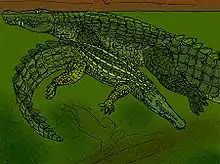Baru
Baru is an extinct genus of Australian mekosuchine crocodilian. It was semi-aquatic, around 4 m (13 ft) in length. Being semi-aquatic its habitat was around fresh pools of water in wet forests, ambushing their prey, much like modern species. The word Baru is Aboriginal and means "crocodile's ancestor".[2]

| Baru Temporal range: Late Oligocene - Middle Miocene | |
|---|---|
| Scientific classification | |
| Kingdom: | Animalia |
| Phylum: | Chordata |
| Class: | Reptilia |
| Order: | Crocodilia |
| Family: | Crocodylidae |
| Subfamily: | †Mekosuchinae |
| Genus: | †Baru Willis et al., 1990 |
| Species | |
| |
Fossils have been found in Australia at Riversleigh in north-western Queensland and Alcoota Station it the Northern Territory.
Species
There are currently three valid species within the genus Baru. The type species B. darrowi is known from the Middle Miocene of the Northern Territory and is the largest reaching size of 4–5 m in length. It is named after English actor Paul Darrow.[3] Two older species, B. huberi and B. wickeni are known from the Late Oligocene Etadunna Formation of Queensland.[1]
References
- P. M. A. Willis. 1997. New crocodilians from the late Oligocene White Hunter Site, Riversleigh, northwestern Queensland. Memoirs of the Queensland Museum 41(2):423-438
- P. Willis, P. Murray, and D. Megirian. 1990. Baru darrowi gen. et sp. nov., a large, broad-snouted crocodyline (Eusuchia: Crocodylidae) from mid-Tertiary freshwater limestones in Northern Australia. Memoirs of the Queensland Museum 29(2):521-540
- "Baru darrowi - Australian Museum". australianmuseum.net.au. Retrieved 2017-11-02.
External links
| Wikispecies has information related to Baru. |
